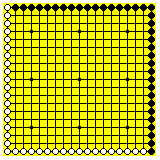
The same board of 19 points by 19 points that is used for the game of Wei Ch'i or Go is also used for other games.
I will not describe Go Moku and Niniku Renju here, as they are described in many general books on board games.
On another page, I describe Warring States Chess, a large multiplayer chess variant from China that predates Avalon Hill's game of Diplomacy as a game for seven players. But I will not attempt to describe Ko Shogi here except to note that while the pieces are shown as discs, similar to those in Chinese chess, since the larger Shogi variants did not include drops, and therefore wedge-shaped pieces that could be turned around to point in the opposite direction are not a requirement for them, even though they were used, and in Ko Shogi, the pieces have individual promoted forms, it seems that the evidence favors thinking of it as a Shogi variant, rather than a Xiangqi variant, even though the round pieces, played on the points of a Go board, certainly make one think of Xiangqi.
One game, referred to as Ming Mang in R. C. Bell's Board and Table Games from Many Civilizations, which may actually have been given a name which, in scholarly transliteration, is bKugom bu Chos, can be considered to be Tibet's answer to the game of Checkers.

In this game, the pieces move like the Rook in Chess. There is a modified form of custodian capture in this game; a piece of the opponent's, or any number of the opponent's pieces in a straight line, that become between two of your men by your move are not only captured, but replaced by men of your own color. This form of custodian capture à la Reversi can under some circumstances leave one's own men vulnerable to recapture. Also, as in Reversi, there is no special rule to overcome the immunity of a piece in the corner to capture.
A game, presumably played according to rules similar to those which applied to Tablut, was played by the mediaeval Saxons.
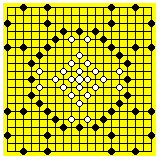
A surviving fragment of one board allows one, assuming symmetry, to reconstruct the arrangement of pieces shown here; however, which pieces were white and which black is merely a surmise. I've seen the game referred to as "Saxon Hnefetafl", but Hnefetafl was played on a smaller board, although few details are known; this game is also called Alea Evangelii.
The rules of Tablut are these: pieces are subject to custodian capture, except the largest white piece, which must be surrounded on all four sides to be captured. The usual restrictions apply; a piece surrounded on the two available sides in the corner of the board is captured. As well, a man can move between two of the opponent's men without being captured because of that. Black wins by capturing White's large piece, the King, and white wins by moving the King to the edge of the board.
An additional rule of Tablut is that the white King is the only piece that can move in to the center of the board, and so the white King can be captured if surrounded on three sides by the opponent's pieces if that space is on its fourth side. Since the center square is not as prominently marked on boards for this game as on those for Tablut, it is likely these rules are not present.
Having given the rules for the game of Tablut, I should also provide an image of its board and the opening array of its pieces, although that diverges somewhat from the topic of this page:
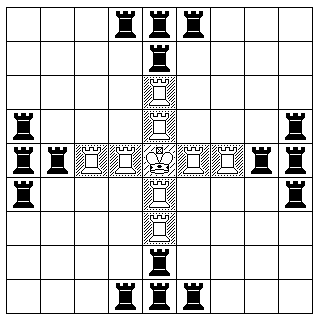
The square on which the King rests is here depicted as lighter than the other dark squares; actually, that square is usually decorated with an ornate cross.
One other game of this type that survived well enough so that its rules are well known was the version found in Wales, Tawlbwrdd.
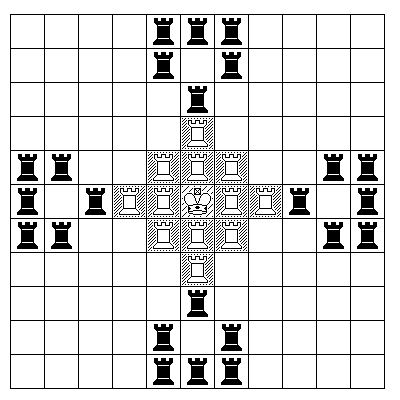
This is its board and the initial arrangement of its men. The board is shown in the same style as that for Tablut, although the surviving examples indicate that instead the rows of the board alternated between a darker and a lighter color.
There are also some other surviving games of the Tafl group with boards smaller than that of Tablut.
The Puzzles and Games Ring of the Archimedian Mathematics Society at Cambridge University devised a game which is played on the spaces, rather than the points, of the Go board, which may rank as the most complex and profound game ever invented, Gess. This game was mentioned in the November 1994 issue of Scientific American, from whence it first came to my attention.
The initial setup of the board is shown in the diagram below:
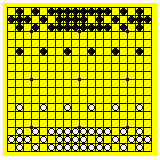
This diagram shows what is going on,
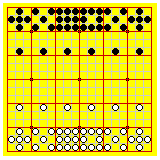
but in one way, it is very misleading about the game.
With the board divided by the red lines into 36 groups of 3 squares by 3, it is clear that the array suggests a version of Chess played on a 6 by 6 square board without Knights:
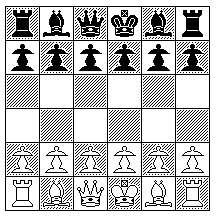
But that is not all that it is. Any 3 by 3 area of squares on the board may be thought of as a piece, as long as it only contains stones of one color within it. In addition, while stones cannot move off the 18 by 18 board, for the purpose of forming the area of 3 by 3 squares which defines a piece, the board can be thought of as extended to 22 by 22 with two additional courses of squares around it. The outer eight squares in such an area show the directions where the piece can move, the corner squares indicating diagonal motion, those in the middle of a side orthogonal motion, and the middle square, if it has a stone in it, indicates the piece can move any number of spaces, like a Rook or Bishop. If it is absent, in addition to moving "one space", from the viewpont of a board built up of larger 3 by 3 squares, which is really moving 3 spaces on the real board, it can move two spaces or one space. Similarly, when the center stone is present, the number of spaces moved does not need to be a multiple of three.
One combination recieves special treatment, the piece that can move "one space" in each direction. That is the King, and its capture wins the game for the capturer, so to avoid losing, one must always have a configuration of stones somewhere that is a hollow square. One can have two Kings at the same time, or more, to make oneself harder to defeat.
Usually, taking stones from an odd location would break up pieces, leaving one's forces weaker, yet limiting oneself strictly to thinking of it as limited Chess on a 6 by 6 board will cause one to overlook opportunities; the extra possibilities generated by the higher granularity of the board are what gives the game its immense profundity.
Such games as Byelorussian Cheskers and Shashmaty have been devised because it was felt that combining checkers with chessmen, and compelling a capture of some kind, by a chessman or a checker, when a checker can make a capture, would provide a more challenging game than ordinary Chess, just as adding the compulsion to capture made Checkers a more challenging game.
Inspired by this, I present Gheskers:
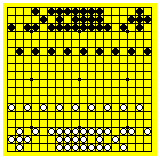
where, in addition to the 3 by 3 square with stones everywhere but in the center being special, because it is the Chess King, whose capture ends the game, those with two stones in the two forward diagonal positions, and those with one stone in each of the four corners only, are also special, being the Checker Man and Checker King respectively, which move one space diagonally, capture by jumping over the opponent's piece three spaces away to a space six spaces away, and are compelled to capture when they can.(or, alternatively, the player may make another type of capture with another piece).